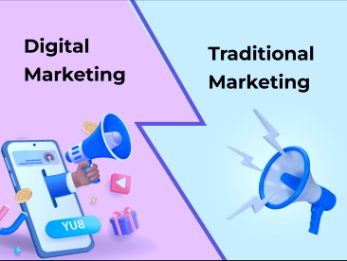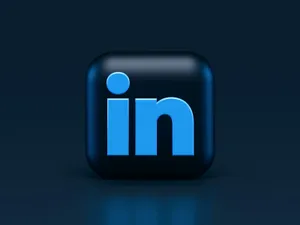Digital Marketing vs Traditional Marketing: Which one is better?
5 mins | 23 May 2023

Marketing is all about getting your message in front of your target audience. In the past, this was mainly achieved through traditional marketing methods, such as TV ads, radio spots, billboards, and print ads. These methods were effective because they allowed businesses to reach a large audience with a single message.
However, as the world has become more digital, traditional marketing methods have become less effective. Consumers are no longer passive recipients of marketing messages; they now have the power to choose what they want to see and when they want to see it. They can skip ads, use ad-blockers, or simply tune out altogether.
This is where digital marketing comes in. Digital marketing uses the internet and digital technologies to reach customers and promote products and services. This includes channels such as social media, email marketing, search engine optimization (SEO), and pay-per-click (PPC) advertising.
One of the key advantages of digital marketing is its ability to target specific audiences. For example, social media platforms allow businesses to create highly targeted ads based on user demographics, interests, and behaviors. This means that businesses can show their ads to people who are more likely to be interested in their products or services, which can lead to higher conversion rates and a better return on investment (ROI).
In summary, while traditional marketing methods still have their place, digital marketing has become an essential component of any successful marketing strategy. In the rest of this blog, we'll dive deeper into the differences between digital marketing and traditional marketing, and explore why businesses should consider incorporating digital marketing into their overall marketing mix.
First, let’s have a detailed look into the new-age form of marketing i.e. digital marketing.
Digital Marketing
What is digital marketing?
Digital marketing is the practice of using digital channels and technologies to promote products or services and reach customers. It encompasses a wide range of tactics and techniques, including search engine optimization (SEO), pay-per-click (PPC) advertising, social media marketing, email marketing, content marketing, and more.
The goal of digital marketing is to create a strong online presence, attract and engage customers, build brand awareness, and ultimately drive sales or conversions. With the increasing use of the internet and digital technologies, digital marketing has become a crucial part of any modern marketing strategy.
What are the pros and cons of digital marketing?
Pros:
- Targeted audience: One of the biggest advantages of digital marketing is the ability to target specific audiences with precision. Through platforms like social media and Google Ads, businesses can reach customers based on demographics, interests, behaviors, and more, which can lead to higher conversion rates and a better return on investment.
- Cost-effective: Digital marketing is often more cost effective than traditional marketing methods like TV or print ads. Many digital channels, such as social media or email marketing, are relatively inexpensive, making them accessible to businesses of all sizes.
- Real-time results: With digital marketing, businesses can track and measure the results of their campaigns in real time. This means they can quickly identify what's working and what's not and make data-driven decisions to optimize their strategy for better results.
- Greater reach: The internet is a global network, which means that businesses can reach audiences around the world with digital marketing. This can help to increase brand awareness and drive growth for businesses with a global presence.
Cons:
- Highly competitive: With the rise of digital marketing, competition for online attention has become fierce. Businesses need to work hard to stand out in a crowded market and get their message in front of the right people.
- Rapidly changing: Digital marketing is a rapidly changing field, with new technologies, platforms, and trends emerging all the time. This can make it challenging for businesses to keep up with the latest developments and stay ahead of the competition.
- Dependence on technology: Digital marketing relies on technology, which can be vulnerable to outages, cyber-attacks, and other issues. This means that businesses need to have contingency plans in place to ensure their campaigns can continue even in the event of a technological failure.
- Ad fatigue: With so many ads competing for attention online, customers can quickly become fatigued and tune out altogether. This means that businesses need to work hard to create engaging and relevant content that will capture their target audience's attention and keep them engaged.
Overall, while digital marketing offers many benefits, it's important for businesses to be aware of the potential challenges and risks involved and work to mitigate them as much as possible.
What are the different techniques used in digital marketing?
There are various techniques used in digital marketing, here are some of the most common ones:
- Search Engine Optimization (SEO):
SEO is the process of optimizing your website to rank higher in search engine results pages (SERPs). This involves a combination of on-page optimization (e.g., optimizing your website's content, meta descriptions, and title tags) and off-page optimization (e.g., building backlinks and improving your website's domain authority).
- Pay-per-click Advertising (PPC):
PPC is a form of online advertising where advertisers pay each time a user clicks on one of their ads. The most popular PPC platform is Google Ads, which allows businesses to create targeted ads that appear at the top of search results pages.
- Social Media Marketing:
Social media marketing involves using social media platforms (such as Facebook, Instagram, Twitter, LinkedIn, etc.) to promote your brand, engage with your target audience, and drive traffic to your website.
- Content Marketing:
Content marketing involves creating and sharing valuable, relevant, and consistent content to attract and retain a clearly defined audience, ultimately driving profitable customer action.
- Email Marketing:
Email marketing involves sending promotional messages or newsletters to a list of subscribers. This can be an effective way to build relationships with your audience, promote your products or services, and drive traffic to your website.
- Influencer Marketing:
Influencer marketing involves partnering with individuals who have a large following on social media to promote your products or services to their audience. This can be an effective way to reach a new audience and build brand awareness.
- Affiliate Marketing:
Affiliate marketing involves partnering with other businesses or individuals to promote your products or services in exchange for a commission. This can be an effective way to drive sales and build brand awareness.
- Video Marketing:
Video marketing involves creating and sharing video content to promote your brand, products, or services. This can be an effective way to engage your audience and build brand awareness.
These are just a few of the many techniques used in digital marketing. The key is to use a combination of these techniques in a way that is tailored to your business needs and goals.
What can be the best digital marketing strategy for a brand?
Although, there’s no one-size-fits-all strategy when it comes to formulating a digital marketing strategy for a brand; we have come up with a digital marketing strategy that has given us success all these years.
Here are the steps you can follow:
- Define your client's goals:
The first step in creating a digital marketing strategy for your client is to understand their business goals. What do they want to achieve with their digital marketing efforts? Do they want to increase sales, generate leads, improve brand awareness, or something else? Understanding their goals will help you create a more effective strategy.
- Identify the target audience:
Once you understand your client's goals, you need to identify their target audience. Who are they trying to reach? What are their needs, interests, and pain points? Understanding the target audience is essential for creating a digital marketing strategy that resonates with them.
- Determine the budget:
Your client's budget will determine the tactics you can use in your digital marketing strategy. Determine how much your client is willing to spend and allocate the budget across different channels and tactics.
- Conduct a competitive analysis:
Analyze your client's competitors and identify what they're doing well and what can be improved. This will help you identify gaps in the market and opportunities for your client to differentiate themselves.
- Choose the appropriate digital marketing channels and tactics:
Based on your client's goals, target audience, and budget, choose the appropriate digital marketing channels and tactics. This could include social media marketing, search engine optimization (SEO), pay-per-click (PPC) advertising, email marketing, content marketing, and more.
- Create a content calendar:
Once you've identified the digital marketing channels and tactics, create a content calendar to plan and organize the content that will be used in each channel. The content should be tailored to your client's target audience and aligned with their business goals.
- Set up tracking and measurement:
It's important to track and measure the effectiveness of your client's digital marketing strategy. Set up tracking and measurement tools such as Google Analytics, and regularly review the data to identify areas that need improvement.
- Regularly review and optimize the strategy:
A digital marketing strategy is an ongoing process that requires constant monitoring and optimization. Regularly review the performance of the strategy and make changes as needed to improve its effectiveness.
By following these steps, you can create an effective digital marketing strategy that helps your client achieve their business goals.
Want to have an effective digital marketing strategy for your brand? Get in touch with the 12Grids team.
Traditional Marketing
What is traditional marketing?
Traditional marketing refers to the use of traditional media channels such as television, radio, newspapers, magazines, billboards, and direct mail to promote a product or service. It has been in use for decades and is still relevant in some industries today.
In traditional marketing, businesses often rely on one-way communication to reach their target audience. For example, a company might create a TV commercial or print advertisement and broadcast it to a large audience without any direct interaction. The goal of traditional marketing is to reach as many people as possible and generate brand awareness.
However, traditional marketing can be expensive and not always effective. With the rise of digital marketing, many businesses are shifting their focus to online channels and techniques to reach their target audience more effectively and cost-efficiently. Nonetheless, some industries still rely on traditional marketing as an effective way to reach their target audience.
What are the pros and cons of traditional marketing?
Pros:
- Wider reach: Traditional marketing channels have the potential to reach a large audience, making them an effective tool for businesses targeting a broad customer base.
- Tangibility: Traditional marketing allows for tangible products such as flyers, brochures, and billboards, which customers can physically interact with, potentially creating a more memorable experience.
- Familiarity: Traditional marketing has been in use for decades and is a familiar advertising medium for many people. This can create a sense of trust and credibility among customers.
Cons:
- High cost: Traditional marketing can be expensive, especially for small businesses, making it difficult for them to compete with larger companies that have more significant budgets.
- Limited audience targeting: Traditional marketing often targets a broad audience, which may not be effective for businesses that need to reach a specific demographic or niche market.
- Difficulty in tracking ROI: Measuring the effectiveness of traditional marketing campaigns can be challenging, as there is no direct way to track the ROI of each campaign.
- Inability to interact with customers: Traditional marketing is often a one-way communication medium, which means businesses have no direct interaction with customers, making it difficult to build long-term relationships with them.
In summary, while traditional marketing can be an effective tool for reaching a broad audience, it can be expensive, difficult to track ROI, and limit audience targeting. As a result, many businesses are turning to digital marketing, which offers a more targeted audience reach and a measurable ROI.
What are the different techniques used in traditional marketing?
Here are some traditional marketing techniques that are commonly used by businesses:
- Print advertising:
This includes newspaper and magazine ads, flyers, brochures, and direct mail. Print advertising is a popular way to promote products or services to a wide audience.
- Broadcast advertising:
This includes TV and radio commercials, which are widely used by businesses to promote their products or services to a large audience.
- Outdoor advertising:
This includes billboards, signs, and posters that are placed in public areas such as highways, transit stations, and shopping centers. Outdoor advertising is a great way to capture the attention of people who are out and about.
- Events and sponsorships:
Businesses can sponsor events such as concerts, sports events, and festivals to promote their brand and connect with their target audience.
- Telemarketing:
Telemarketing involves making phone calls to potential customers to promote a product or service. While it can be effective, it's also considered intrusive by many people.
- Public relations:
This involves building relationships with media outlets and journalists to generate positive coverage for a business or brand.
- Personal selling:
This involves salespeople meeting with potential customers in person to promote and sell products or services.
- Product demonstrations:
This involves showcasing a product or service to potential customers to demonstrate its benefits and features.
In summary, these traditional marketing techniques can be effective for businesses that want to reach a broad audience and create brand awareness. However, they can be expensive, have limited targeting capabilities, and may not be as measurable as digital marketing techniques.
What can be the best traditional marketing strategy for a brand?
As is the case with digital marketing, there is no one-size-fits-all answer to this question since the most effective marketing strategy for a brand will depend on several factors, such as the target audience, the industry, and the budget. However, some traditional marketing strategies that have proven to be successful for many brands include:
- Advertising on television and radio:
Television and radio advertising can be a great way to reach a large audience quickly. With TV advertising, you can create engaging commercials that capture the attention of viewers, while radio advertising can be a more cost-effective option that still reaches a large audience.
- Print advertising:
Print advertising includes ads in newspapers, magazines, and billboards. This approach can be particularly effective for local businesses trying to reach a specific audience in their area.
- Direct mail:
Direct mail marketing involves sending physical mail, such as postcards, flyers, or letters, directly to potential customers. This approach can be effective for promoting new products or services or targeting specific demographics.
- Events and sponsorships:
Sponsorships of events, such as concerts or sports games, can be a great way to generate brand awareness and reach a large audience. Participating in trade shows or conferences can also be effective in reaching a more targeted audience.
- Referral and word-of-mouth marketing:
Encouraging your satisfied customers to refer your brand to their friends and family can be a powerful marketing strategy. You can also incentivize referrals by offering discounts or other rewards.
Ultimately, the best traditional marketing strategy for a brand will depend on the brand's specific goals, target audience, and budget. It's essential to carefully evaluate different strategies and track the results to determine what works best for your brand.
Final Thoughts
In conclusion, both digital marketing and traditional marketing have their strengths and weaknesses, and the best marketing strategy will depend on the specific needs and goals of a business. Traditional marketing strategies, such as TV and radio advertising, print advertising, direct mail, events, and sponsorships, have been effective for many years and can still be effective in reaching a broad audience. However, digital marketing strategies, such as search engine optimization, social media marketing, email marketing, and content marketing, have become increasingly popular in recent years due to their ability to reach a targeted audience, track and analyze performance, and provide a high return on investment.
While traditional marketing may be more expensive and difficult to track, it can still play a significant role in a marketing campaign. At the same time, digital marketing has revolutionized the marketing landscape and has opened up new opportunities for businesses to reach their target audience. Ultimately, the most effective marketing strategy will involve a combination of both traditional and digital marketing methods to reach a wide audience and maximize return on investment.
Author







